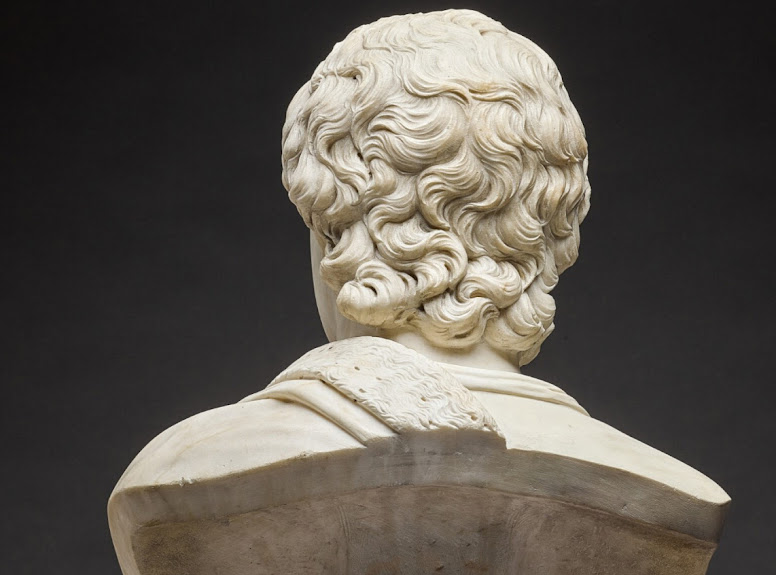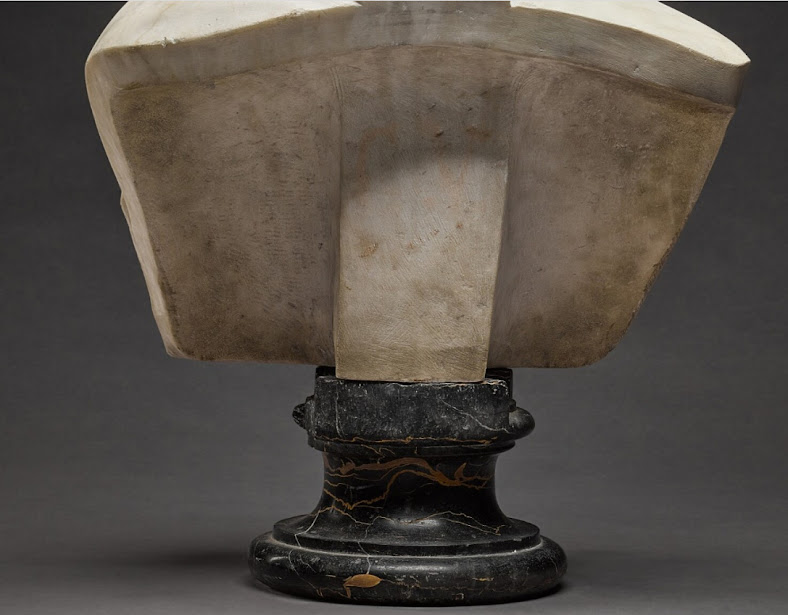Images below from de Breffny.
Current whereabouts unknown.
Aubrey Beauclerk, (1740 - 1802) 2nd Baron Vere of Hanworth, subsequently 5th Duke of St Albans
Height 67 cms.
He succeeded to the Barony of Vere of Hanworth on the death of his father 2 October 1781.
Married in 1763.
He and his wife were in Rome from May 1778 - 81.
Henry and Martha Swinburne were in Rome at the same time as the Duke and Duchess in 1779 and won a prize in a raffle the Duchess gave and presented it to Sir Thomas Gascoigne.
All three had their busts made by Hewetson and cast in bronze by Valadier.
Christies attributed the pair of busts to Hewetson on stylistic grounds which seems fair.
Provenance - by descent to the Duke of St Albans and sold by him at Christies 9 July 1979 (catalogue page 11).
Current whereabouts unknown.
Lady Catherine Beauclerk, subsequently Baroness Vere of Hanworth, and Duchess of St Albans.
nee Ponsonby.
Formerly Lady Catherine Ponsonby daughter of the 2nd Earl of Bessborough.
Marble bust.
Info below TrDictionary of British and Irish Travellers in Italy..... ed, Ingamells pub. Yale 1996.
Footnotes in brackets.
1778—81 Rome (May 1778—early 1781) [Germany by Feb. 1781]
On 4 June 1778 Lady Mary Coke was told that 'Mr Beauclerke,
Lady Catherine and Mr Brand [Thomas Brand, d. 1794] were gone together abroad,
being so in debt they found it troublesome staying at home'.(l).
Lady Catherine had committed a 'little indiscretion' to which
her father asked Beauclerk to attend, (2) doubtless her relationship with Brand (who had left a wife
and children behind in England).
They took with them their eldest daughters,
Catherine (d. 1803) and Caroline (d. 1838).
They were in Rome by May 1778, where their eldest son Aubrey
(1765—1815, later 6th Duke of St Albans) joined them, (3). and Thomas Bowdler
noticed them there in November. (4 ).
They were to spend nearly three years in Rome, during which
they were active as collectors. In September 1779 they sent home 'diversi
marmori consistenti nella maggior parte in restauri moderni' (and Brand sent back
eight marble columns at the same time and a further consignment of marble fragments,
a vase and two modern mosaic pictures on 11 April 1780).(5)
Smuglewicz painted two family portraits (Christie's, 23 Jun.
1978, (6) and Cheltenham AG), the first with a view of Castel
Gandolfo, where the Beauclerks rented apartments through the summer of 1779. (7).
It was probably James Byres who suggested this commission;
Smuglewicz had painted the Byres family and the 1790 inventory of Byres's house listed
a portrait of Mr Beauclerk by [Solomon] Williams and an engraving of Lady Catherine
Beauclerk. (8)
Busts of Aubrey and Lady Catherine have been attributed to Christopher Hewetson (Christie's, 9 Jul. 1979). (9).
In February 1779 Lady
Catherine organised a raffle for the marble relief of Alcyone and Ceyx by
Thomas Banks, (10) apparently to aid the sculptor on his return journey to England,
see Banks.
The Beauclerks left Rome with the Irish painter Solomon
Delane; they were in Germany by February 1781, (11) and reached England at the
end of August. (12)
Their return may have been prompted by Baron Vere (who d. 2 October
1781) although, according to Lady Mary Coke, they had had no intention of returning
while he was alive. (13)
Thomas Brand remained
abroad thinking it 'more proper not to arrive in England at the same time'. (13).
As 5th Duke of St Albans, Aubrey Beauclerk sold a large part
of his collection on 8/9 June 1798 to finance the rebuilding of Hanworth; the
sale catalogue described the works as 'collected during a long residence at
Rome, and other parts of the Continent' and included marbles from Centocelle, a
Farnese Hercules restored by Albacini, several bronzes by Zoffoli, and
paintings by Marco Ricci, Marieschi, and Delane.
1. By Ldy. Mary Lowther, see Wal.Corr., 33:294n.
2. D. Adamson & P. Beauclerk, House of Nell Gwynn,
88—90.
3. Swinburne, Courts, 1:214.
4. Eg.2001, f.216 (7 Nov.
1778).
5. ASR ABA 12, f.290 (28 Sep. 1779), f.294. (11 Apr. 1780).
6. F. Russel, Burl. Mag.,
7. Knight Letters, 75, 79. Bankes MSS (H. Bankes, 14 Jul.
1779).
8. Byres MSS.
9. Hewetson 1986, 60.
10. Swinburne, Courts, 11234.
ll. Add.36493, f.128 (Irvine, 10 Feb. 1781).
12. Wal.Corr., 33:293n3.
13. Wal.Corr.,
............................
.
.............................
Portrait of The Hon. Aubrey Beauclerk and his Family, in an elegant interior, a view to the Castel Gandolfo beyond.
Franciszek Smuglewicz (Warsaw 1745-1807 Vilno)
Image courtesy Bonhams Auctions, Lot 73, 8 Dec 2010.
https://www.bonhams.com/auctions/17863/lot/73/
Portrait of The Hon. Aubrey Beauclerk and his Family, in an
elegant interior, a view to the Castel Gandolfo beyond.
oil on canvas.
66.2 x 73.8cm (26 1/16 x 29 1/16in).
Provenance -
The sitter and thence by descent to the 13th Duke St. Albans
By whom sold, Christie's, London, 23 June, 1978, lot 128
Where purchased by the family of the present owner.
LITERATURE:
D. Adamson and P. Beauclerk Dewar, The House of Nell Gwyn.
The Fortunes of the Beauclerk Family 1670-1974, (London, 1974), ill., opposite
p. 95 (as attributed to Pietro Longhi)
F. Russell, 'A Second Conversation Piece by Franciszek
Smuglevitz', in The Burlington Magazine, vol. 120, no. 904, July 1978, pp.
466-469.
Essay below from Bonham's Website.
The present work depicts The Hon. Aubrey Beauclerk
(1740-1802), later 5th Duke of St. Albans, and his family including his eldest
son Aubrey (1765-1815, later 6th Duke of St. Albans), who joined his parents in
Rome in May 1778, and their two eldest daughters, Catherine (d. 1803) and
Caroline (d. 1838).
On 4th June 1778, Lady Mary Lowther noted in a letter to
Lady Mary Coke that 'Mr Beauclerk, Lady Catherine and Mr Brand were gone
together abroad, being so in debt they found it troublesome staying at home'.
Their trip abroad may have been arranged to try to escape the rumours of an
affair between Lady Catherine and Thomas Brand. The Beauclerks spent almost
three years in Rome during which time Smuglevicz painted them twice. One of
these portraits is the present work, which depicts the family before the Castel
Gandolfo where they rented apartments for the summer of 1779. The other
portrait (now in Cheltenham Art Gallery) shows the family in the Roman campagna
with an aqueduct in the background.
The attribution of the present painting to Smuglevicz was
first suggested by Francis Russell in his Burlington Magazine article in 1978.
His attribution was in turn based on that established by Brinsley Ford for his
Portrait of James Byres and his family and also for that of the Portrait of
James Byres and his family in an interior now in the Scottish National Portrait
Gallery, Edinburgh. The present painting compares very well with these two
works both in the distinctive, subdued palette and in the meticulous treatment
of the drapery, particularly that of Lady Catherine's dress.
Franciszek Smuglevicz moved from his native Warsaw to Rome
in 1763 where he trained with Anton von Maron. It may well have been through
the latter that Smugelvicz met James Byres, the antiquary, art dealer and
cicerone for many British Grand Tourists in Rome. Byres himself commissioned
two portraits from the Polish painter, as detailed above, and he is certainly
known to have introduced other tourists to Smuglevicz (for example, he recorded
payment to the artist on behalf of Philip Yorke, later 3rd Earl of Hardwicke,
for a double portrait of Yorke and his Swiss tutor, Colonel Wittestein, most
probably the work offered at Christie's, London, 16 April, 1982, lot 16). Very
few works by Smuglevicz are known and it is surprising that, given his clear
connection with James Byres, he is not known to have executed more commissions
of this type for British Grand Tourists in Rome during his 20 year stay in the
city.
Saleroom notices -
The present painting will be included in the article 'A
speculative Grand Tour excavation: Aubrey Beauclerk, Thomas Brand and Thomas
Jenkins at Centocelle', by J. Yarker and C. Hornsby, in the 'The British Art
Journal', December, 2010
---------------------
Thomas Banks (1735 - 1805).
Thomas Banks in Rome.
Thomas Banks and his wife were in Italy from 1772 -79. For the first three years he was supported by the scholarship from the Royal Academy and the next four years at his own expense.
1777/78 the Banks family lived with painter James Durno (1745 - 95) who had arrived in Rome in June 1774, in the Stalla di Mignanelli, near the Piazza di Spagna.
Banks was treated very shoddily by the capricious Frederick Hervey, the Earl Bishop of Derry - who commissioned Cupid catching a butterfly on his wing and then reneged on the deal - it was eventually sold to the Empress of Russia, and George Grenville, later the Marquis of Buckingham refused to pay 200 guineas for a relief of Caractacus before Claudius and offered only 100 guineas.
He was seriously ill in 1779. In order for him to return to England Lady Catherine Beauclerk (later Duchess of St Albans (her bust and that of her husband were made by Hewetson cast in bronze by Valadier) organised a raffle for his Alcyone (see below) - it was won by Henry Swinburne (also portrayed by Hewetson) who gave it to Sir Thomas Gascoigne (also portrayed by Hewetson) - it is now at Lotherton Hall near Leeds.
for Banks busts see -
https://english18thcenturyportraitsculpture.blogspot.com/2019/01/thomas-banks-list-of-busts.html
and for what I suggest is possibly an early self portrait -
https://english18thcenturyportraitsculpture.blogspot.com/2019/01/bust-of-roubiliac-or-not.html
Alcyone and Ceyx.
Thomas Banks.
Marble relief.
0.78 x 1.12 (30 3/4 x 44 1/8 inches)
Originally at Parlington Hall, Aberford, West Yorks - the Family Seat of the Gascoignes.
Parlington Hall was abandoned in 1905 and finally demolished in 1952.
A version of this sculptural relief was exhibited at the Royal Academy in 1775, see Biog Dictionary ...Yale which states it is Marble (this needs to be confirmed - I suspect that it was a terracotta or plaster macquette).
Image courtesey the Paul Mellon Photographic Archive
for a good general biography and list of works see -
https://gunnis.henry-moore.org/henrymoore/sculptor/browserecord.php?-action=browse&-recid=119
For more on the works of Thomas Banks see my post-
https://english18thcenturyportraitsculpture.blogspot.com/2019/01/thomas-banks-list-of-busts.html
-----------

























,_by_Franciszek_Smuglevicz.jpg)











